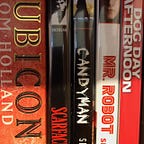Images, Words & Collaborations
Or, journeys in the world of editing
It’s a deceptively simple assumption: to create a successful photobook all that’s required is a great photographer and an editor who understands the demands of working with text and image. A good collaboration between the two then frees the editor to make the raw text beautiful. Having finished editing one student’s photobook as part of my RMIT studies, and worked on the early stages of another, I think it’s much more complex than that.
Photobooks — the theory
A photobook that really works is one that has a strong visual narrative spine. Take away the text and the photobook should still exist, tell its own story without the benefit of those carefully honed words. No, that doesn’t mean that writers and editors are redundant. Rather, the reverse.
I’m trained in fine art and graphic design, and have worked in the design industry. This definitely helped me in terms of understanding the process of telling a story visually. It also helped in following the demands the project put on the photographers.
Extroverts and introverts
I worked on two photobooks: the entirety of Roberto Pettinau’s Park Street Pasta and Wine, and on the early stages of Igor Hill’s photobook on Pokemon collector’s culture. Both photographers have a great eye for an image, but their subject matter diverged greatly. Restaurants, both behind the scenes and in front of house have a natural drama to them. As subject matter goes, they’re extroverts. The hunt for Pokemon is an intriguing part of contemporary culture, but documenting it and building a strong narrative is inherently tricky. Pokemon collectors may not all be introverts, but capturing the drama and telling a story with those images takes skill and a tactical approach — rather like hunting a prize Pokemon.
As an editor working on those two very different books, I found for both that the text didn’t truly ‘click’ for me until the basic backbone of the story and images was set.
Processes
Early editorial meetings with Igor Hill concentrated on looking through the images he had and deciding on a tactic for future photo shoots to develop and sharpen the personalities — the photobook’s cast — giving the book its dramatic narrative. As a non-Pokemon expert, I suggested using the same approach a photographer documenting any totally disparate, yet linked, mass of people would follow — say, a crowd that barracks for a football team or racegoers at a track. Photobook viewers shouldn’t have to understand the rules of football, or what makes punters choose one horse over another. All they need is to see the human drama and want to follow it. The obsession may be abstract, the emotion, the narrative and the characters are not. The trick is to find the thread of those characters and their stories and bring it into sharp focus. Once that’s done, captions don’t have to do the work of the images, but when used, enhance them.
For me, this was pure developmental editing under a different guise. Instead of working with an author on a manuscript, in this case the artist’s medium was photography, not words. It was a fascinating process.
Park Street Pasta and Wine was not so much a tactical approach on how to approach the subject, but rather, a honing of existing text, writing fresh text and working with the photographer, Roberto Pettinau, on which images might best tell the story and what might be required to further round out the narrative. Restaurants have great characters, and the photographs captured them — and the excellent food. Again, while the images could stand alone to form the narrative, the text itself had to be engaging, pared back and clear, enhancing the readers understanding and enjoyment of the book.
Multitasking
None of this weakens the contribution of a good editor or devalues the collaboration between photographer and editor. In fact, it renders it more essential. An editor with a good visual eye and a writer’s understanding of narrative can not only edit — and write — text, they can function as a visual editor and with that understanding of narrative, help identify any weaknesses in the story.
For me, it parallels a developmental editor’s work on a novel. The questions in many ways are the same: does the story involve the reader? Does it have characters who engage you? Does it have a good narrative flow? Is there drama, tension, resolution? Beautiful words aren’t enough. Neither are beautiful images. Both have to push the narrative forwards, form a cohesive whole.
A successful photobook will do all of those things. It will capture the imagination and give the reader a unique insight into a different world. It’s a trip, a journey, and it should use all the tricks of storytelling to draw the reader in. A good editor can help provide that, and a good collaboration between editor and photographer will draw on the creative strengths and disciplines of both to create something both beautiful and memorable.
I would like to thank Igor Hill and Roberto Pettinau for providing such great images and concepts to collaborate on, and to congratulate them on their photobooks.
